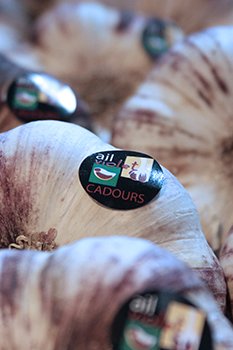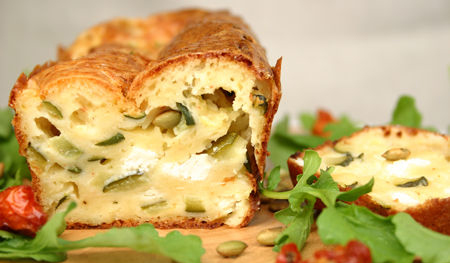Cadours Violet
Garlic
The colour of a region



 Country : France
Country : France
Region : Midi-Pyrénées
Department : Haute-Garonne
Commune : Commune of Cadours
Postal code : 31480
Mayor - Current term : Didier LAFFONT since 2014
Inter-municipality : Community of municipalities in the Commune of Cadours
Population : 1 047 inhabitants (2007)
Density : 99 inhabitants/km2
Demonym : Cadoursians
Coordinates : 43° 43′ 45″ North - 1° 03′ 02″ East
Altitude : min. 147 m — max. 242 m
Superficie : 10,58 km2
A commune located in the Pays de Rivière-Verdun in south west France, in the north eastern part of the Haute-Garonne, between Gers and Tarn-et-Garonne. The countryside has many hills with villages perched on top, giving the region a distinctly Mediterranean feel. It is located 39 km from Toulouse, 220 km from Bordeaux and 700 km from Paris.
One of Cadours most famous inhabitants was undoubtedly the motor racing driver Raymond Sommer, known as "The Wild Boar of Ardennes", after the race at Cadours-Laréole in September 1950. He died on 10 September 1950 after driving off the track during the same race. He was driving a Cooper and hit a tree. A stone was erected in his memory on the road out of Cadours towards Laréole at the crossroads of the D29 and D89. The high street also bears his name.
Other famous motor racing drivers spent time in Cadours, including Maurice Trintignant and even Juan Manuel Fangio.
The Minister of Trade and Industry Jean Cruppi also came in 1909 and visited the train station accompanied by his friend Auguste Débans, the Mayor of Grès, among others.

Its coat of arms is Quartered : It shows a silver river with vert-coloured waves against gules, a silver castle against azure, golden fleurs-de-lys against azure and a golden capital C against gules.
Located 39 km west of Toulouse, Cadours is the capital of this commune in Haute Garonne and used to be part of the ancient province of Gascony. It is the final destination of a railway of local interest from Toulouse to Cadours. It is roughly the same distance from Auch, Montauban and Toulouse.
The municipality borders Morguestoud to the east, a small tributary of the Garonne, and the Pest to the west, a tributary of the Gimome that flows into the Garonne. The borders to the north and south are a little artificial; the southern frontier meets the department of Gers.
Reminiscent of the Lauragais landscape, Cadours is surrounded by hillsides and valleys at an altitude of 240 metres. The Haute Garonne Tourist Board Association's guide from 1932 already highlights Cadours as a local tourist destination.
Tourists can visit the surroundings, too: the Monastery of Saint Mary of Egypt founded in 1852, the Cox potteries and the Laréole Chateau, built in 1579 by Dominique Bachelier. Further away, beyond Cologne (Gers) in the same direction, lies the ancient home of Soluste de Barthes, the 16th century poet from Gascony. On your way to visit the potteries, you can admire the hilltops of Cosc, which offers a magnificent view of the Pyrénées. Walkers will find plenty to discover as they wander through the countryside to the south west, with its serene and restful scenery.
Despite research into the name's etymology, we don't know its true origin. There are 3 possibilities:
A bear head, a hunting trophy, may have been on display for a long time in a cabin that occupied the same spot as today's church. Every time anyone mentioned this cabin, they called it the "Cabin of Cap d'Ours" (Bear Head Cabin), which turned into Cadours.
- The word Cadours could also have come from Arabic and may date back to the Saracen invasion (732 CE). In Morocco, many families bear the name Kadour. One of these families may have stayed in France and given its name to this part of the country
- The most probable hypothesis: Cadours may originate from the Latin word Cadourcium. Four notices of appeal in Latin dating back to 1930 mention Cadours under the nae Castrum de Cadurcio.
Once upon a time, there were two villages, two churches and two cemeteries in the spot where Cadours is today.
The village of St Hilaire : This village stretched from the fort (where a castle once stood) to today's cemetery. The oldest houses are in this part of Cadours. Created after 1318, the village disappeared bit by bit. The church of St Hilaire (destroyed in 1890) stood where today's cemetery chapel now stands, which was demolished and then rebuilt.
Notre Dame de Vie : Only a small part of this village remains (2043). Today's houses are modern. The houses were aligned to create wide streets in 1775. The street names also date back to this period. The church of Notre Dame de Vie was located north of the Merchants' Hall (built in 1723). Today's church only dates back to the end of the 18th century. Notre Dame de Vie's cemetery, on the north side of today's church, fell out of use after 1794. St Hilaire's cemetery remains, which was more convenient for holding funerals. Today's cemetery was walled up in 1857 and the first vault dates back to 1821.


 CADOURS VIOLET GARLIC, THE SYMBOL OF A REGION
CADOURS VIOLET GARLIC, THE SYMBOL OF A REGION
In Cadours, there has been a strong link between violet garlic, the land and local farmers for many generations.
Cadours Violet Garlic is characterised by its purple tunic with blueish purple lines. It is large and has a very round shape. The cloves are large, ivory-coloured and have a regular shape, sometimes with faint blueish purple lines.
It is the oldest garlic in France. It comes into season in July and keeps easily until February if you store it at room temperature in the kitchen.
Cadours Violet Garlic is locally produced according to a variety of factors:
- Cultivated land is located on the hillsides and is generally south-facing. The soil in these areas is clay-limestone with minimal clay content (20%).
- The local microclimate, which is rainy in May, encourages growth and bulbing. It also affects the size of the bulb and its purple colour. The very dry Autan wind encourages the open-air drying process: the garlic is harvested with its foliage and bundled together before being hung from sticks in closed barns.
The traditional method preserves the violet garlic's organoleptic qualities. Choosing the variety is just as important as choosing the land. Through years of cultivation and clonal improvement, two varieties of Violet Garlic have emerged: the Germidour variety and, more recently the Valdour variety. The plants require adapted technical specifications and constant surveillance throughout their development. The producer's attention never wavers until the drying stage and the delicate operation of peeling the garlic by hand. The key is to avoid taking off too much of the tunic and skin so the colour is preserved. The garlic is then packed in different types of traditional or modern packaging depending on the distribution channel. Cadours Violet Garlic can then be sold directly in retail outlets or via distributors in the local area.
.
La délimitation de l'aire géographique s'appuie sur :
- des facteurs naturels propices à l'élaboration du produit, facteurs climatiques et géopédologiques,
- des facteurs humains, liés aux usages d'implantation des parcelles d’ail violet et des opérateurs.
Toutes les opérations de la production de l’ail jusqu’à son conditionnement ont lieu dans l’aire géographique qui totalise 106 communes situées au confluent des départements de
Cadours Violet Garlic is presented as follows:
- A string holding a minimum of 9 bulbs with stems. Its weight varies from 500g, 1 or 2 kg depending on the number of bulbs and their size.
- A bunch of four bundles of garlic with stems weighing 8-12 kg,
- A bouquet of garlic with stems weighing 500 g and 1 kg,
- 5 kg sacks, packed by hand, taken from bulbs with the stems removed,
- Trays packed by hand for bulbs measuring 60-70 mm or over,
- String bags, 3 heads or 500g
- A tub of 3 heads
- A basket for bulbs with the stems removed measuring 60-80 mm, packed by hand.
Bulk sales are not permitted. The bulbs in sacks and trays can also be sold individually to the customer.
To preserve the product's quality, packaging is ventilated so that the product is visible and bulbs don't knock together.
To achieve a uniform presentation, the colour, shape and size of the bulbs must be consistent. The diameter of the largest bulb should not be more than 20 mm larger than the smallest bulb.
The different ways of packaging Cadours Violet Garlic were developed within this geographical area due to the product's fragility and in order to preserve the appellation's quality and specific characteristics.
The product's quality relies on local expertise, particularly in selecting bulbs in order to achieve a uniform presentation in terms of size and colour.
Moreover, all Cadours Violet Garlic packaging is identified as soon as it is produced for the purposes of tracking.
Violet Garlic Strings are produced by hand on farms. The garlic is braided together tightly so that the string is rigid and can be easily handled. The strings are braided using the smallest bulbs first and the largest bulbs last so they look even. For a string weighing 500g, the size of the bulbs should be between 45 mm and 60 mm. For strings weighing 1 kg and over, the smallest bulbs should be 50 mm. The tips of the foliage are trimmed evenly and then tied with a ribbon or a piece of twine.
Bunches are produced by hand on farms. The four bundles of garlic are gathered together and bound with twine. This has to be done tightly to ensure the bunch is rigid and can be easily handled. The tips of the foliage are trimmed evenly but remain long so the bunch can be carried.
Bouquets are produced by hand on farms. The first three bulbs are tied together and the others are added around them. The twine must be tight to ensure the bouquet is rigid and can be handled easily. The tips of the foliage are trimmed evenly.
5 kg sacks are produced by hand on farms. The first layer of bulbs is arranged on a root tray facing the bottom of the sacks. For every successive layer, the bulbs are placed on a root tray facing outwards around the circumference of the sack. The sack is tied as closely to the bulbs as possible to maintain their presentation.
Trays are produced by hand. The garlic is placed on straw or shredded paper in wicker baskets. The first layer of bulbs faces up and the second layer of bulbs faces down.
Baskets are produced by hand. The garlic is placed on straw or shredded paper in wicker baskets. The first layer of bulbs faces up and the second layer of bulbs faces down.
String bags are tied as tightly as possible to prevent the bulbs knocking together. Bags weighing 500 g should contain bulbs that are 60-80 mm or 50-60 mm. String bags with three heads of garlic should contain bulbs that are 45-60 mm and 60-80 mm
Tubs, should contain three bulbs arranged on their sides and packed tightly to prevent them knocking together during handling.
The Violet Garlic Association has submitted an application for the AOC label. The result should be received soon.
The appellation area has been submitted for approval, which should be granted at the end of June 2013.
The AOC label guarantees the quality and origin of French food products.










Since the 1960s, producers have worked together to protect their product, develop its production and build its reputation. They formed the Association for the Protection of Cadours Violet Garlic in order to:
- research and produce technical specifications for environmentally-friendly production.
- seek to improve the local population
- build up a reputation for their garlic
Producers came together around this project and were followed by local traders in partnership with local collectivities, including Cadours Town Hall, the Departmental Chamber of Agriculture of Haute-Garonne, the Departmental Councils in the three departments covered by the appellation area and professional agricultural organisations, such as Crédit Agricole.
A new momentum began in 2000 when producers decided to start proceedings to apply for recognition for Cadours Violet Garlic with the AOC label.
The Association now groups together 60 producers and 4 traders, which represents the majority of Violet Garlic production in the three departments: 31, 82 and 32, with the key objective of working closely with other members to obtain the AOC label. The Association relies on the involvement of its members.
An administrative committee formed of industry representatives is held every two months in order to finalise specifications, put in place internal and external monitoring of each stage of production until products are put on the market, participate in local festivals (SISOA, the Cadours Violet Garlic Festival, the L'Isle Jourdain Fair and the Moissac Fruit and Vegetable Festival) and national festivals (Paris Agricultural Competitions) and finally, to protect their product by working together with the ANIAIL (National Inter-Professional Garlic Association).
Every year, members and partners are invited to attend a General Assembly during which the annual financial report is presented. Members are actively involved in the Association throughout the year and receive a newsletter called "Cadours Violet Garlic", which is sent out every three months.
A Tireless effort thanks to the energy of the association's members and the popularity of Violet Garlic among consumers, and despite the slow process of reeiving recognition.
HOW TO FIND US: CADOURS VIOLET GARLIC FESTIVAL THE 27 TO 28 AUGUST 2016 IN CADOURS
Garlic paste is one of the earliest known recipes and dates from Roman times. In the Middle Ages, Plautus described a stew with garlic called Alliatum, more commonly known as "Aillade" in French.
Crops are spread across three departments: Tarn and Garonne, Gers and Haute Garonne.
The lighter the green, the more concentrated the production.
To view the locations of Cadours Violet Garlic, please click on these boxes.



Serves 6 
Ingredients:
Goose or duck fat
2 heads of garlic
1 onion
2 eggs
Salt + pepper
Bread croutons
Quick preparation time, 30 minutes cooking time
Boil 2 litres of water.
Melt a spoonful of goose fat in a frying pan and caramelise a few peeled cloves of garlic and 1 small onion without burning them.
Pour the mixture into boiling water with a handful of crushed garlic and the rest of the peeled garlic.
Add salt and pepper, then boil for 30 minutes.
Break two fresh eggs.
Pour the egg whites into the soup.
Take the pan off the heat and fold in the egg yolks.
Mix everything together.
Pour into a soup tureen over slices of stale bread or croutons and leave to soak, preferably with a lid on.
Serve hot.
Serves 6 
Ingredients:
1.5 heads of Cadours Violet Garlic (large and full of flavour)
Herbes de Provence
180g flour
100 ml (3.5 fl.oz.) milk
100 ml (3.5 fl.oz.) oil
3 eggs
1 packet of baking powder
Salt + pepper
Quick preparation time, 30 minutes cooking time
Mix the flour, milk, oil, eggs, baking powder, salt and pepper in a bowl. (Seasoning can be left out if you prefer as the garlic has a strong flavour). If you have a Thermomix, mix for 30 seconds on speed 8.
Crush the garlic (using a garlic press) and add to the mixture. Add the Herbes de Provence according to taste (you need enough to give the loaf colour and flavour).
Pour the mixture into a greased bread pan (or lined with greaseproof paper).
Bake for 1 hour (checking it regularly) in a medium-hot oven (gas mark 5/6, 150° to 180°).
Serve hot or cold.


 32 rue de Lisieux
32 rue de Lisieux Hôtel de Région Toulouse
Hôtel de Région Toulouse Hôtel de Région Toulouse
Hôtel de Région Toulouse 1, boulevard de la Marquette
1, boulevard de la Marquette  81 route de PessanBP 20569
81 route de PessanBP 20569 100 boulevard Hubert Gouze
100 boulevard Hubert Gouze Hôtel d'Entreprises
Hôtel d'Entreprises 
 Rue Mairie, Cadours
Rue Mairie, Cadours  Maison du Tourisme
Maison du Tourisme




